Archive for November, 2015
Snow Monkey: a review of George Gittoes’ new film at its Sydney premiere
Nov 11th
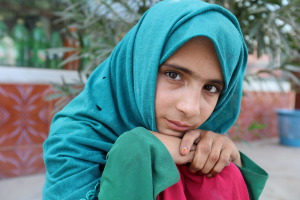
Shazia, from George Gittoes’ documentary film, Snow Monkey. Picture supplied by George Gittoes.
I’ve just been getting to know some of the street kids in the roughest parts of Jalalabad. This is Afghanistan’s second largest city, and reportedly the most dangerous city on earth.
I met wide-eyed, gorgeous little Gul Mina, aged about five, who collects discarded cans in hessian bags and sells them for a few rupees to support her large family.
I met Irfan, a delightful nine-year-old boy whose father does little but smoke hashish. Irfan sells ice creams from a rickety little cart filled with ice, as do many of the street kids of Jalalabad. This is how they help families survive.
I met Saludin, another ice cream boy. His dad is a polio victim who endures taunts of “dog” and “donkey” when he walks the streets begging on all fours.
There was Zabi, a lad with Hollywood looks who is certainly destined to become a filmmaker.
I met Steel, a boy of only nine or 10, whose hard and life-damaged face strikes fear into young and old. Steel heads a notorious Jalalabad gang and wields a razor, a knife or a syringe in order to extort money.
I met little Shazia, aged 11. Pretty as a princess, though dressed in rags, she is the devoted girlfriend of Steel. Shazia and Steel have vowed to marry. But only, says Shazia, if Steel gives up his gang and leads a better life. She doesn’t want to be married to a gangster – even one who declares he would die to protect her.
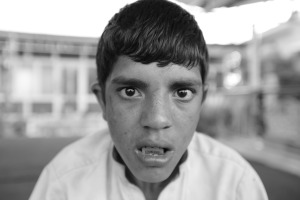
Steel, gang leader. From the documentary film Snow Monkey, by George Gittoes. Picture supplied by Gittoes.
So I didn’t actually meet these kids in Jalalabad. I’ve never even been to Jalalabad. But after watching George Gittoes’ new documentary film, Snow Monkey, at its Sydney premiere tonight at the Museum of Contemporary Art Australia, I feel as though I’d been right there with them.
In Snow Monkey, Gittoes tells the story of how he invited the kids into the Yellow House that he and partner Hellen Rose set up in Jalalabad in 2011 as a safe house of creativity for men, women and children. The Yellow House is full of music and art, and local people come here to learn acting and filmmaking.
In Snow Monkey, the daily survival struggle of the Jalalabad street kids is carved in high relief against the seething, crazy, dog-eat-dog life of Jalalabad. But humour is never far from Gittoes’ filmmaking, leavening those scenes which are truly grisly. The most challenging scenes in Snow Monkey, shot by Zabi who learned to use a cinecamera from Gittoes at the Yellow House, are of the sickening carnage caused by a suicide bomber who self-detonated outside the Kabul Bank in Jalalabad in April.
Snow Monkey is a tour de force by Gittoes, who received the Sydney Peace Prize last night (November 10, 2015). Receiving the prize from Lord Mayor Clover Moore, Gittoes spoke about his many decades as a witness to the atrocities inflicted by people against people. He also spoke about the resilient spirit which propels many war victims to rise above the truly shocking horrors visited on them by conflict.
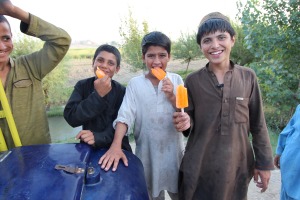
Jalalabad ice cream boys (left to right) Irfan, Saludin and Zabi. Picture supplied by George Gittoes.
The Museum of Contemporary Art Australia is hosting free screenings of Snow Monkey, as well as some of Gittoes’ other documentary films. You would be doing yourself a favour if you, too, spend time and get to know the street kids of Jalalabad.
Elizabeth Fortescue, November 11, 2015, Sydney.
George Gittoes and the Sydney Peace Prize: an interview from Artwriter’s archives
Nov 8th
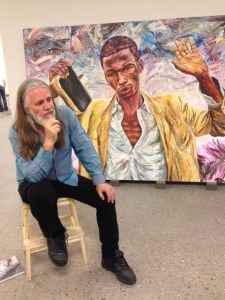
George Gittoes, 2014, photographed by Elizabeth Fortescue at Hazelhurst gallery, Gymea
The Australian artist George Gittoes will receive the prestigious Sydney Peace Prize on Tuesday November 10, 2015. It’s a high accolade that’s been won by the likes of Desmond Tutu.
Ahead of the Peace Prize ceremony at Sydney Town Hall that day, I wanted to devote a post to Gittoes and his extraordinary body of work.
I have delved into my archives and found a 1999 interview that I conducted with Gittoes at his then home base in Bundeena.
It is reproduced below, with some edits, as my small tribute to this amazing artist who is, typically, not planning the usual Peace Prize “lecture” but who has been busy making puppets for a performance that he, his partner Hellen Rose and a variety of dancers and helpers are planning to enliven the Town Hall on Tuesday night.
I hope you enjoy reading this 1999 interview. It came about because I was doing a story on Gittoes for the Daily Telegraph. He had just returned from Afghanistan, where he had focused on gathering stories from land-mine explosion survivors. It is interesting to note that this was 1999, two years before the events of September 11, 2001.
Gittoes: I tell you, I’ve never felt so much as if I was in an alien universe as I have just on this trip in Afghanistan. It’s unbelievable. It’s possible to spend a month in Afghanistan without ever seeing a woman’s face. It’s real apartheid for women. I’ve worked in South Africa where there was apartheid for the blacks, but at least blacks could more or less move around, but this is apartheid for women and it’s ten times worse than anything I’ve witnessed with blacks.
At the moment the Taliban are having the biggest war they’ve ever had. They’re using tanks and MIGs and it really is more extreme visually than Star Wars because, you know, they capture a tank and the Taliban cover it with Koran writing, and they’ve got these MIGs that are covered with blessings from the Koran. They captured them from the Russians 15 or 16 years ago and you’d see these turbaned guys that come up to work on a donkey and then they start working on the MIG and you think, well, gee, I wouldn’t like to be the pilot.
When I was in Afghanistan I lived with de-miners, the people who were getting rid of the mines. They’re all Afghans and former Mujahideen, they’re all soldiers, so that was a fantastic insight, to get into their whole history and psyche and way of life.
The Taliban have only been in power two years. The Koran says you’re not allowed to represent any living thing. That’s why you can’t take photographs. There’s also something in the Koran against music, so they’ve banned music. And now English and American nationals have been banned by the governments from going into Afghanistan. I was able to work there fairly well because a group of Australians have set up the whole de-mining thing and they’ve been there for 10 years, and the head of UNOCHA which is the UN de-mining is Ian Bullpit, and Ian’s been there for seven years, so Australians are about the only people who can safely move in Afghanistan. The Taliban respect them because they’ve organised this de-mining thing.
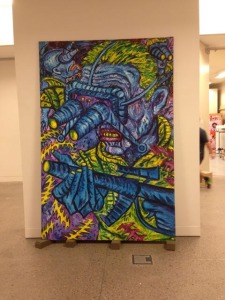
A painting by Gittoes of a soldier wearing night vision goggles.
Gittoes spoke about how land-mines are a scourge of many countries, not just Afghanistan:
I’ve been in Cambodia, I’ve been on the Thai-Burma border, and the Thai-Cambodian border, and I’ve been in the tribal belt of Pakistan and Afghanistan, and they’re just about the most mine-affected places in the world. Ian Bullpit was very happy to facilitate me getting into Afghanistan and working with all these mine victims.
The Taliban were happy for you to be there?
Only because I came under the flag of de-mining. About the only good thing that’s being done by the world for Afghanistan is the de-mining. Virtually all other aid has been pulled off. And I knew that this was a crucial time to be in Afghanistan because it was the anniversary of the rocket attack on Bin Laden where the Americans attacked Afghanistan. That’s why I organised to be in Afghanistan at that time. And I think the media’s losing touch with what’s happening in Afghanistan, and you can understand why. Basically they’ve had 20 years of war and the world’s tired of hearing about it. I’ve worked in every war-torn country in the world from Bosnia to Cambodia to Rwanda and Somalia and so on, and I’ve never seen such a totally destroyed country. The thing that pissed me off the most was there are two 2000 year old Buddhas, that are world famous, they’ve been studying them in art books since I was a kid, and they’re about 260 feet high or something, and I was trying to see them the other day and I discovered the reason why they’re being resistant was the Taliban have just recently been using them as target practice and destroyed them. I was furious. I said, you might be into Islamic religion and you might see them as Buddhism, but if you’d left them there it shows how Islam triumphed over Buddhism. And I said are they reparable? And they said oh no, the heads have been just blown to dust. And so the whole country’s been destroyed and there’s virtually nowhere for people to live, and all the ruins of the houses have been booby trapped with land mines and they’ve got unexploded artillery shells and so on.
Gittoes talked about some of the extraordinary stories he collected from land-mine victims in Afghanistan.
I went into the hospital in Kabul and it was like pre Florence Nightingale. The whole place was full of people who’d lost arms and legs and things to mines, and they were lying in there with flies all over them and no intravenous drips, and a lot of them were children. Because the children go playing in places where the parents wouldn’t be stupid enough to go. There was one father and son I met that had both been blown up and they’d both lost limbs, and the father had realised the son was out playing in a bad area, ran out and grabbed him, and as he grabbed him the son had hold of a trip wire so he pulled it and it got both of them. There’s one little boy I saw the other day who was riding a donkey and he had his brothers and father with him and they went over an anti-tank mine and it blew the donkey, the father and the two brothers completely to smithereens, and the boy had lost both legs. The mother was now looking after five daughters and him, in a country where there’s nothing, nowhere to sleep or go, and this was the brightest little kid, he’d taught himself English somehow, he was only 13 years old, and walking around on his arms. I’ve got a drawing of him walking on his hands.
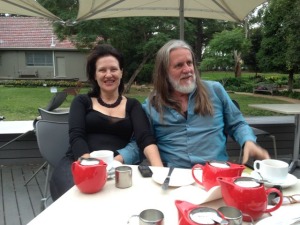
Gittoes and his partner Hellen Rose, photographed by Elizabeth Fortescue in 2014 at Hazelhurst gallery in Gymea
I’ve decided just for a short time to narrow down to this mine thing, because for me it represents humankind at its absolute most insidious because these mines are designed to trick and trap other human beings and they’re done by engineers and scientists all over the world and they’re indiscriminate. And all the research in the world proves that only one of the people who gets hit by a mine in 20 is the intended target. So in a country like Afghanistan they’re only getting one soldier to 19 civilians. I’ve taken about 4000 photographs on this trip and I’ve personally interviewed hundreds of mine victims and so my own experience is in perfect alignment with what international statistics are saying. It just completely destroys lives. In most cases the people die. But those who survive, they’re around for a lifetime. And the worst cases I found were in the tribal belt of Pakistan where I was able to go and interview the women, and it seems pretty well the majority of people in a rural country who get hit by mines are women, and I’ve found this before in Mozambique and Cambodia and so on, because they’re the ones who work in the fields and who walk around for water and so on. In Pakistan I was able to go and see them. They’ve got the same rules as Afghanistan. The full burqa and not being able to see them and everything. But I got in deeper with the community in the tribal belt of Pakistan. But my contact there wasn’t through the de-miners, it was through the community itself. And so probably for the first time ever I was allowed to draw and photograph women. They’re even stricter than the Taliban. There’s one woman I can’t get out of my mind. She was lying on a stretcher sort of a thing, she had both legs blown off above the knee, she had one arm completely paralysed and she’d been blinded. In a wartorn place, covered in flies, and her children all around her, and her husband had been killed. She had six kids.
She could still talk. She said God only knows how we’re going to survive. And the kids were absolutely beautiful. The mine that had done that to her had killed her husband. And the kids, their whole universe was their mother. They were like precariously living in the shade of someone else’s verandah and the kids are still hovering around this woman who was blind, without legs and only one working arm.
In her case it happened four months ago, but she was still bleeding. All their savings had gone into, they had to pay for the hospital and the amputations. So the cost of being prevented from dying usually uses up all the resources they’ve got.
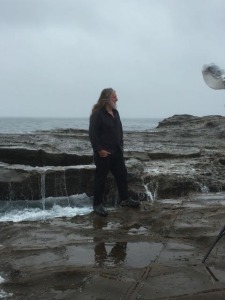
Gittoes at Werri Beach, November 2015, being photographed by Bob Barker for our story in the Daily Telegraph, Sydney
The most inspiring story I had was the people in the border area of this tribal area of Pakistan. There are more mine victims there than I’ve found anywhere else in the world and there’s no international aid agencies helping them. I was the first western person to visit it, ever. Everywhere I went was mined and there’s no de-miners, so I was constantly thinking when am I going to tread on one. One place they decided to get a whole lot of handicapped people (injured by land-mines) to come in and meet me. I was inundated. I had 40 or 50 people. And one old man just stuck out. And then I discovered that the woman he’d bought with him, he’d carried her for six hours. She had both legs missing. He’d carried her for six hours to meet me. He was 75 years old. He was the father in law. The husband was in Karachi trying to earn money to pay the debt that they owed the hospital for having to have her legs amputated. And she had six children. She said through a translator, she said I hate these mines and what they mean, I’m happy to devote the rest of my life to fighting against them. Now she’s agreed to be the ambassador for the handicapped in Pakistan and they’re going to raise the money within her village to send her to Rome where all the land-mine people are meeting.
A feature of Gittoes’ ability to manage his work in war-torn areas is that he makes friends with local people, follows their stories from year to year, and delights in seeing how many people can recover their lives even after they’ve been maimed by land-mines. Here, he speaks about one man called Ta Brang in Cambodia. He had lost his legs, but Gittoes returned to Cambodia to find him thriving.
Ta Brang, the man from (my picture) The Legless Bike, in 1993 he was living on the side of the road with his wife, and he’d lost both of his legs up his hips, and they had nothing, and he was just starting a bike repair business. And I went back to him now, six years later, he had a two week old new born baby in his arms. He’s now got five kids, he turned the bike repair business into a motorbike repair business, he’s built a nice house, and actually having no legs means it’s really easy working on motorbikes because he’s got access to them. I found that all the mine victims that I’d gotten to know and start to worry about in 1993, every one of them had made a huge amount of, you know, they’ve had more.
The blind guitarist of Angkor Wat, he’s the one that had been tortured by Pol Pot, he’s been reunited with his wife, she was in a refugee camp, he was being held as a prisoner, and so I met his wife. He’s getting on really well with his life, making money out of his music. He was a beggar in 1993 and couldn’t find his wife.
A lot of people say, are you depressed by what you see? But the fact that I’ve been doing this for so many years I’m able to see the turn-around. I just can’t express the inestimable pleasure in finding that these people had managed so well and were doing so well. The great thing was seeing Ta Brang with his two week old baby. He’s in Siem Reap.
Elizabeth Fortescue, November 8, 2015, Sydney
